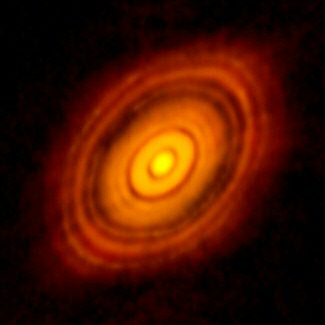From the interstellar medium to the formation and evolution of planetary systems
All stars and planets, throughout the history of the universe, are formed from gas and dust. This gas and dust is commonly found in galaxies and known as interstellar matter (ISM). Interstellar matter is part of the overall life and death cycle of stars and successively enriched in heavier elements.
At the densest locations, star and planet formation (SPF) occurs. The interstellar gas comprises atomic hydrogen and helium, and with increasing density also molecules like carbon-monoxide, water, and many more. The interstellar dust consists of small silicate particles ('sand') and carbonaceous material ('soot') and forms the material from which eventually planets like Earth are growing.

Key questions
The Kapteyn Institute has developed a strong profile in research on the interstellar medium and the formation of stars and planetary systems. More recently, this research line expanded to include also planet formation and evolution as well as moon formation and habitability, hot topics thanks to the discovery of thousands of exoplanetary systems over the past decades.
Some of the key questions that drive current research at Kapteyn in this area include:
-
How do dust grains influence the chemical composition of interstellar and circumstellar matter?
-
What is the origin of the diversity of stellar masses?
-
How do young stars affect their surroundings and influence future star formation?
-
What is the organic and water content of planet-forming disks?
-
How are the compositions of planet forming disks tied to those of observed exoplanets and potentially moons?
-
Which processes determine the delivery of water and organic material from disks to planets?
-
How do protoplanets differentiate into core, mantle, and atmosphere during planetary growth?
-
How do terrestrial planets solidify and form their long-lived atmospheres?
-
Which processes govern the structure and composition of terrestrial planets and exoplanets?
-
Which exoplanets/exomoons are habitable and how can we study them?
The scientific questions, which are also closely connected to those of the Dutch ORIGINS centre, are:
-
What are the main physical and chemical processes shaping the demographics of terrestrial exoplanets?
-
What is the diversity of prebiotic, secondary atmospheres on terrestrial planets?
-
How frequent are modern Earth-like climate and surface states on terrestrial exoplanets?
-
How do planetary atmospheres betray evolutionary processes on the planets themselves?

Projects
Some of the projects, programmes, and instruments in which the group is involved, are:
-
Physics and chemistry of the ISM in our Milky Way and nearby galaxies, using Herschel, ALMA, NOEMA and JWST
-
ALMA and JWST studies of the chemistry of planet-forming disks
-
Physical structure of high-mass star-forming regions
-
Physical and chemical structure of dense, warm terrestrial-planet-forming regions
-
Chemical processes in space probed by laboratory experiments with the Zernike Institute for Advanced Materials
-
Cycling of volatile elements between interior and atmospheric reservoirs on lava exoplanets.
-
Tectonic and atmospheric evolution of ultrashort-period terrestrial exoplanets
-
Chemical composition of exoplanet atmospheres (JWST, ARIEL, LIFE)
Leading roles
Kapteyn staff have leading roles in the observing programme on NASA's recently launched James Webb Space Telescope, in on-going ALMA development efforts, in APEX/SEPIA, the ELT-METIS instrument, and in the definition of the Large Interferometer for Exoplanets (LIFE) space mission concept. They also participate in the Ariel and PLATO missions.
Scientific staff
Academic staff working in this field are: Baryshev, Kamp, Lichtenberg, Shipman, van der Tak, Changeat.

